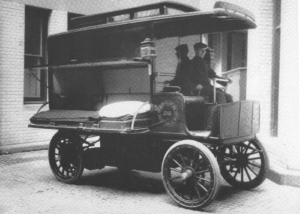1909 Electric Ambulance belonging to the Lying In Hospital of the City New York
In 1799 the Lying-In Hospital of the City of New York, the first to provide obstetrical care for women in New York City, is established. Then, in the early 1800s, the hospital becomes affiliated with New York Hospital.

LYING-IN HOSPITAL OF THE CITY OF NEW YORK
The dreadful yellow fever epidemic in the summer of 1798, with its toll on expectant mothers, activated interest in founding a lying-in hospital in New York City. Dr. David Hosack, an attending physician at New York Hospital, initiated an appeal for money; Alexander Hamilton was one of the first subscribers. In 1799, a commodious house at No.2 Cedar Street served as the hospital, but, because of financial difficulties, the house closed after the first year. An arrangement was then made to have the patients hospitalized in a ward of New York Hospital. It was during this period that medical students were allowed in maternity wards to witness delivery for the first time in this country.
The lying-in ward at New York Hospital was closed permanently in 1827, and the cooperative arrangement was terminated, probably because of a financial misunderstanding. Because of lack of public interest, nothing further was done until 1855 when a system of home care for women requiring assistance during confinement was implemented. During this period, money was saved to establish a lying-in hospital.
In 1887, two American medical students, James Wright Markoe and Samuel W. Lambert were learning obstetrical procedures on a mannequin at the Frauenklinik of Von Winkel in Munich, Germany. They were inspired to establish a similar dispensary, the Midwifery Dispensary, for teaching medical students in New York. This they did in 1890, using a home at 312 Broome Street. By coincidence, Samuel Lambert’s father learned of the existence of the inactive philanthropic organization known as The Society of the Lying-In Hospital. Shortly thereafter, in 1890, this organization absorbed the Midwifery Dispensary, giving it the much-needed funds to expand and to improve its services.
John Pierpont Morgan, an affluent patient of Dr. Markoe, was responsible for the next important advance, the purchase in 1894 of the Hamilton Fish Mansion on Second Avenue and 17th Street to be used as the Lying-In Hospital. This was later expanded toward 18th Street. In 1899, the facilities were overtaxed and the need for a larger hospital was evident. The generosity of Morgan made possible the demolition of the mansion and the construction of a modern, eight-storied hospital that opened in 1902.
John Pierpont Morgan, Jr. carried on the philanthropy of his father; and, being concerned for the long range financial stability of the hospital, convinced John D. Rockefeller, Jr.; George F. Baker, Sr.; and George F. Baker, Jr. to join him in funding an association with New York Hospital. As a result, when New York Hospital-Cornell Medical Center opened in 1932, the Lying-In Hospital became the Obstetrics and Gynecology Department of New York Hospital, occupying one of the pavilions along the East River.
Above history was revised and adapted from “History of the New York Hospital-Cornell Medical Center,” an article by Ralph Engle, Jr., M.D., that first appeared in the medical center’s Directory of Alumni and Staff, 1980.
Submitted to NEMSM April 2010, author unknown
